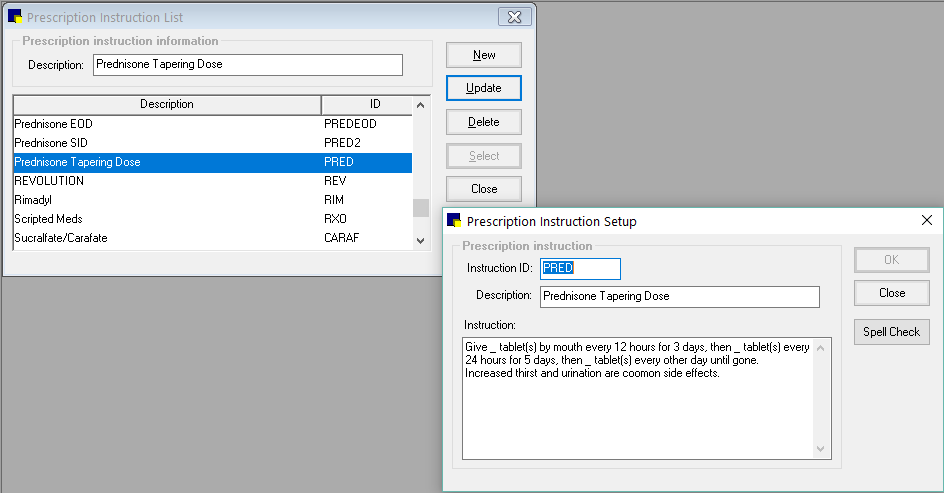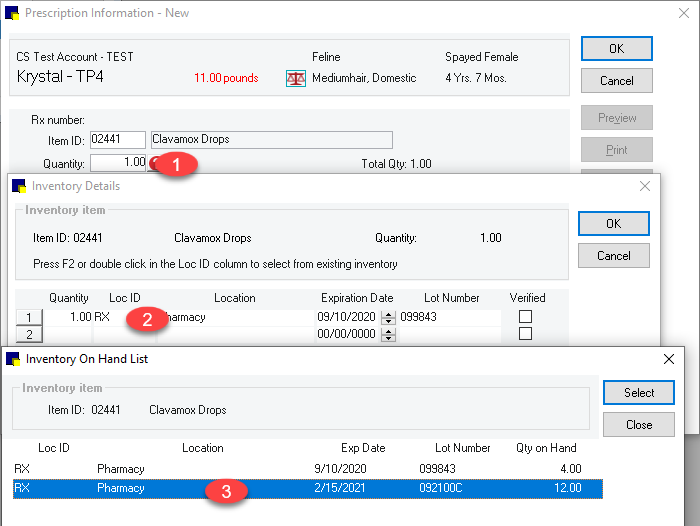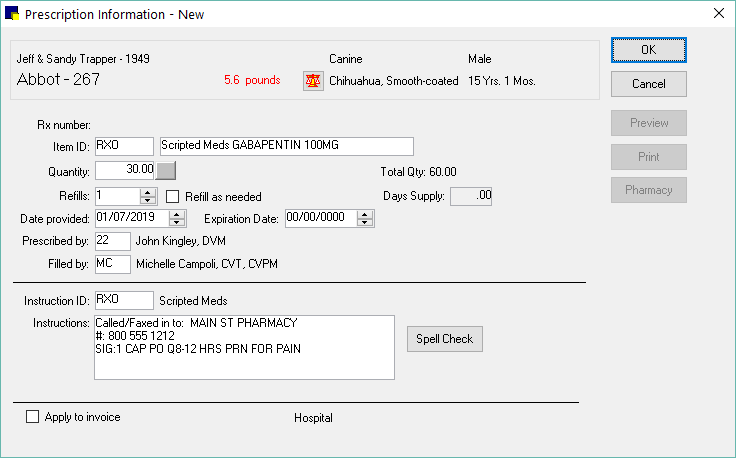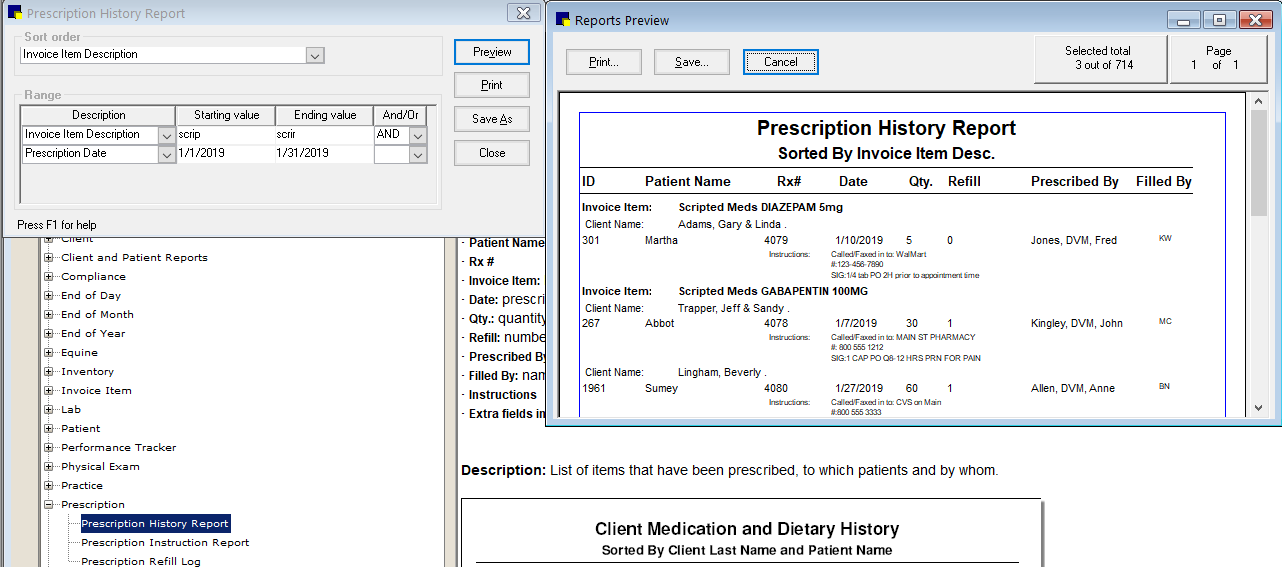IDEXX Cornerstone Software
News and information
Providing prescriptions for your patients is a vital and daily occurrence at your practice. And sometimes you may be uncertain about the best way to complete these essential tasks using Cornerstone. Luckily, Cornerstone expert Michelle Campoli, CVT, CVPM, is here with answers to some common and not-so common Rx questions as well as “did you know” tidbits that can give valuable time back to your team.
How can we have instructions entered consistently on prescription labels?
Multiple doctors and team members filling prescriptions can definitely create inconsistency from one prescription to another, especially for the same medication. To solve this, use Prescription Instructions to prefill or choose from at time of creating your prescription labels. When setting these up, use both a simple ID and description that can be entered on the label or used to quickly find on the prescription instructions list (Lists > Prescription Instructions). Medications that never vary instruction-wise, such as monthly heartworm prevention, are no brainers to have as a prefilled label: just add the prescription ID to the item’s Instruction tab, and you’re good to go!
Even medications like Prednisone, where dosing can vary from a short-term acute dose to long-term chronic therapy, are good candidates for Prescription Instructions. You’ll save time, improve label consistently and reduce errors.

Did you know? When creating instructions or on the label itself, you can use Ctrl-Enter to move your cursor to the next line!
We track expiration dates on most of our medications, but often create the labels in the exam room or doctor’s office. How should we verify the expiration date?
If your practice is tracking expiration dates* on your inventoried medications, there are three default settings that can aid your team in filling prescriptions for those items:
- Default in the oldest expiration date (Inventory default under Practice & Workstation defaults)
- Set when inventory details need to be verified (also under inventory defaults)
- Override the expiration date by x months (Prescription default under Practice & Workstation defaults). This will use the earliest of either the actual drug expiration date (useful for short dated product) or the default date (from date prescription created).
Did you know? If you are AAHA accredited, there is a standard to have expiration dates of 12 months or less? (standard PH16j)
My basic rule of thumb for who verifies inventory details is “you fill it, you verify it”:
- If you are making the label and filling in a single step, you verify it immediately on the Rx label window since the bottle is in your hand (or at your elbow, eye level, etc.).
- If you are filling a prescription from a label you grabbed from the printer, you verify the details on the PVL (as that’s where the charge goes when making a prescription) or saved invoice (if not found on PVL, but REALLY should stay on PVL until meds filled and verified!).
How to properly verify when the red circle shows up
- Click the red ? icon to open the Inventory Details window
- If the expiration date and/or lot number are not displayed in the details window, double click in the LOC ID field and select it from the Inventory on Hand List window. Do NOT manually enter an expiration date or lot number unless it is not on the list!

*IMPORTANT: it is imperative you enter inventory receipts with expiration date / lot number details upon shipment arrival. If the information is not entered and someone grabs the new bottle to fill a prescription, they are forced to manually enter the information to verify details which will create a negative quantity on hand for that manual entry.
When we write a prescription to a client, the doctor needs to see it on the RX tab along with other medications we did fill at our hospital.
Handing a written script to a client is more common these days, as is calling in a prescription. Here’s how to add it to the RX tab and help your doctors, as well as have the information display in the prescription list if using the prescription instructions bookmark in your documents.

Setup steps (lists > Invoice Item):
- Use a simple invoice item ID (ex: I use RXO for script out)
- Keep the description short (useful for using and reporting!)
- Mark as a Miscellaneous item*
Optional: add a default prescription instruction
Usage steps:
- On the RX label window, enter the item ID or search by description
- In the description field, add the medication name and strength in all caps following your default description (this helps delineate inhouse and outside prescriptions and with a reporting tip coming up next)
- Fill out label fields as you would for an inhouse prescription – refills, prescribed/filled by instructions, etc. Tip: you can alternately enter the Drug name and strength within the instructions box so it is included in the patient history report.*
- Deselect “apply to invoice” check box and click OK to save label to patient record (but cancel the following print screen
- The Prescription shows on the Summary., Text and RX tabs of the patient record using the description entered on the label.
- The same description will appear for refills and renewals and can be modified as well.


*When using a miscellaneous item for prescription labels, the prescription line in the Patient History report and item sales information reports will display as the hospital description.
How can we review all prescriptions we made last month?
Use the Prescription History report to view all prescription labels made, corrected or voided. It can be run by date range, fill by staff ID, client name or ID or by item description.
Remember that called in RX item tip? Because this item most likely is not invoiced, you can use this report to quantify how many and what is being called in. Just make sure you are leaving the beginning description as is when creating the label, since the range filter is for item description, not ID. And the information you add to the description line on the label also appears on this report!

Lastly, if you enter refills on your prescription labels, have you looked at the Prescription Refill Log (Reports > Prescription labels)? It lists all prescriptions with remaining refills. How cool is that!
